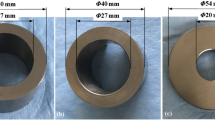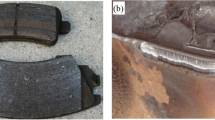Abstract
Reducing friction using lubricant is of great significance to reducing energy consumption and extending the life of machinery. Surface texturing is effective to enhance the lubrication condition, and it is crucial to properly design the texture’s morphology. In this study, a sector-shaped surface texture is designed and demonstrated using both numerical and experimental methods. A computational fluid dynamic method based on Navier–Stokes equations and a two-phase cavitation model is performed to evaluate the effect of the texture in the hydrodynamic lift and to optimize the geometrical parameters of the texture. The mechanism associated with the additional hydrodynamic pressure generation is also revealed according to the results of the simulation. Then, pin-on-disk rotary friction experiments are performed on steel disks textured by a femtosecond laser to verify the lubricant effect of the proposed texture. The results of the experiment suggest that the sector-shaped textures reduce friction more than conventional circle-shaped textures, which coincides well with the results of the simulation.










Similar content being viewed by others
Data availability
All data generated or analyzed during this study are included in this published article.
Abbreviations
- \(B\) :
-
Width of the flow domain
- \(d\) :
-
Distance from the cut lines to the center of the circle
- \(d{\prime}\) :
-
Distance from the intersection of the cut lines to the center of the circle
- \({\text{F}}_{\text{vap}}\) :
-
Evaporation coefficient
- \({\text{F}}_{\text{cond}}\) :
-
Condensation coefficient
- \(h\) :
-
Minimum thickness of the liquid film
- \(H\) :
-
Depth of the texture
- \(L\) :
-
Length of the flow domain
- \({L}_{c}\) :
-
Length of the chevron texture
- \(p\) :
-
Pressure in the lubricant
- \({\text{p}}_{v}\) :
-
Saturated liquid pressure of the lubricant
- \(R\) :
-
Radius of the circle that generates the texture
- \({R}_{B}\) :
-
Bubble radius
- \({R}_{e},{R}_{c}\) :
-
Mass transfer source terms connected to the growth and collapse of the vapor bubbles repectively
- \({S}_{P}\) :
-
Texture area ratio
- \({\varvec{u}}\) :
-
Sliding velocity
- \({{\varvec{v}}}_{{\varvec{v}}}\) :
-
Vapor phase velocity
- \({W}_{l}\) :
-
Width of the chevron texture
- \({a}_{nuc}\) :
-
Nucleation site volume fraction
- \({a}_{v}\) :
-
Vapor volume fraction
- \(\theta\) :
-
An angular geometry parameter of the texture
- \(\mu\) :
-
Dynamic viscosity of the lubricant
- \(\rho\) :
-
Density of the fluid
- \({\rho }_{v}\) :
-
Vapor density
- \({\rho }_{\text{l}}\) :
-
Lubricant density
- \({\text{CFD}}\) :
-
Computational fluid dynamics
- \({\text{CoF}}\) :
-
Coefficient of friction
- \({\text{DI}}\) :
-
Dimensionless
- \({\text{FVM}}\) :
-
Finite volume method
References
Holmberg, K., Erdemir, A.: Influence of tribology on global energy consumption, costs and emissions. Friction 5(3), 263–284 (2017)
Holmberg, K., Erdemir, A.: The impact of tribology on energy use and CO2 emission globally and in combustion engine and electric cars. Tribol. Int. 135, 389–396 (2019)
Gropper, D., Wang, L., Harvey, T.J.: Hydrodynamic lubrication of textured surfaces: a review of modeling techniques and key findings. Tribol. Int. 94, 509–529 (2016)
Tala-Ighil, N., et al.: Effects of surface texture on journal-bearing characteristics under steady-state operating conditions. Proc. Inst. Mech. Eng. Part J J. Eng. Tribol. 221(J6), 623–633 (2007)
Etsion, I.: Increasing mechanical seal life with laser-textured seal faces. In: Proceedings of the 15th International Conf on Fluid Sealing, BHR Group, Maastricht (1997)
Gachot, C., et al.: A critical assessment of surface texturing for friction and wear improvement. Wear 372–373, 21–41 (2017)
Klimczak, T., Jonasson, M.: Analysis of real contact area and change of surface texture on deep drawn steel sheets. Wear 179(1–2), 129–135 (1994)
Niu, Y., et al.: The friction and wear behavior of laser textured surfaces in non-conformal contact under starved lubrication. Wear 476, 203723 (2021)
Walker, J.C., et al.: Influence of contact area on the sliding friction and wear behaviour of an electrochemical jet textured Al-Si alloy. Wear 426–427, 1336–1344 (2019)
Vladescu, S.-C., et al.: The effects of surface texture in reciprocating contacts—an experimental study. Tribol. Int.. Int. 82, 28–42 (2015)
Boidi, G., et al.: Fast laser surface texturing of spherical samples to improve the frictional performance of elasto-hydrodynamic lubricated contacts. Friction 9(5), 1227–1241 (2021)
Etsion, I.: State of the art in laser surface texturing. J. Tribol. 127(1), 248–253 (2005)
Tomar, A.K., Sharma, S.C.: An investigation into surface texture effect on hole-entry hybrid spherical journal bearing performance. Tribol. Int. 151, 106417 (2020)
Galda, L., Pawlus, P., Sep, J.: Dimples shape and distribution effect on characteristics of Stribeck curve. Tribol. Int. 42(10), 1505–1512 (2009)
Pettersson, U., Jacobson, S.: Influence of surface texture on boundary lubricated sliding contacts. Tribol. Int. 36(11), 857–864 (2003)
Chen, K., et al.: Research progress of improving surface friction properties by surface texture technology. Int. J. Adv. Manuf. Technol. 116(9–10), 2797–2821 (2021)
Yin, B., et al.: Experimental research on the frictional performance of real laser-textured cylinder liner under different lubrication conditions. Int. J. Engine Res. 146808742199529 (2021)
Bathe, R.N., et al.: Impact of laser surface texturing (LST) on the tribological characteristics of piston rings and cylinder liners—a review. Part 1: development of LST technology. Trans. IMF 99(5), 231–237 (2021)
Etsion, I.: Modeling of surface texturing in hydrodynamic lubrication. Friction 1(3), 195–209 (2013)
Shen, Z., et al.: Numerical simulation of lubrication performance on chevron textured surface under hydrodynamic lubrication. Tribol. Int. 154, 106704 (2021)
Panigrahi, D.K., Sarangi, M.: Tribological performance of positive deterministic textured surfaces in parallel sliding lubricated contacts: effect of texture size and height. Proc. Inst. Mech. Eng. Part J J. Eng. Tribol. 234(12), 1908–1925 (2020)
Rosenkranz, A., et al.: Influence of surface texturing on hydrodynamic friction in plane converging bearings—an experimental and numerical approach. Tribol. Int. 134, 190–204 (2019)
Rosenkranz, A., et al.: Surface texturing in machine elements—a critical discussion for rolling and sliding contacts. Adv. Eng. Mater. 21(8) (2019)
Rosenkranz, A., et al.: Improved wear behavior of cylindrical roller thrust bearings by three-beam laser interference. Adv. Eng. Mater. 18(5), 854–862 (2016)
Suh, M.-S., et al.: Effect of geometrical parameters in micro-grooved crosshatch pattern under lubricated sliding friction. Tribol. Int. 43(8), 1508–1517 (2010)
Costa, H., Hutchings, I.: Hydrodynamic lubrication of textured steel surfaces under reciprocating sliding conditions. Tribol. Int. 40(8), 1227–1238 (2007)
Dan, L., et al.: Tribological characteristics of a cemented carbide friction surface with chevron pattern micro-texture based on different texture density. Tribol. Int. 142, 106016 (2020)
Zhong, Y., et al.: Numerical simulation and experimental investigation of tribological performance on bionic hexagonal textured surface. Tribol. Int. 129, 151–161 (2019)
Chen, Y., et al.: Multi-objective optimization of micron-scale surface textures for the cylinder/valve plate interface in axial piston pumps. Tribol. Int. 138, 316–329 (2019)
Chang, T., Guo, Z., Yuan, C.: Study on influence of Koch snowflake surface texture on tribological performance for marine water-lubricated bearings. Tribol. Int. 129, 29–37 (2019)
Gropper, D., Harvey, T.J., Wang, L.: Numerical analysis and optimization of surface textures for a tilting pad thrust bearing. Tribol. Int. 124, 134–144 (2018)
Wang, W., et al.: Numerical optimization of the groove texture bottom profile for thrust bearings. Tribol. Int. 109, 69–77 (2017)
Codrignani, A., et al.: Numerical and experimental investigation of texture shape and position in the macroscopic contact. Tribol. Int. 122, 46–57 (2018)
Groper, M., Etsion, I.: The effect of shear flow and dissolved gas diffusion on the cavitation in a submerged journal bearing. J. Tribol. 123(3), 494–500 (2001)
Groper, M., Etsion, I.: Reverse flow as a possible mechanism for cavitation pressure build-up in a submerged journal bearing. J. Tribol. 124(2), 320–326 (2002)
Zwart, P.J., Gerber, A.G., Belamri, T.: A two-phase flow model for predicting cavitation dynamics. In: Fifth International Conference on Multiphase Flow, Yokohama, Japan (2004)
Arghir, M., et al.: Theoretical analysis of the incompressible laminar flow in a macro-roughness cell. J. Tribol.Tribol. 125(2), 309–318 (2003)
Sahlin, F., et al.: Two-dimensional CFD-analysis of micro-patterned surfaces in hydrodynamic lubrication. J. Tribol.Tribol. 127(1), 96–102 (2005)
Cupillard, S., Glavatskih, S., Cervantes, M.: Inertia effects in textured hydrodynamic contacts. Proc. Inst. Mech. Eng. Part J J. Eng. Tribol. 224(8), 751–756 (2010)
Xin, Q.: Friction and Lubrication in Diesel Engine System Design, pp. 651–758. Woodhead Publishing, Sawston (2013)
Johnson, K., Greenwood, J., Poon, S.: A simple theory of asperity contact in elastohydro-dynamic lubrication. Wear 19(1), 91–108 (1972)
Funding
This research was funded by Fundamental Research Funds for the Central Universities: D5000210850, Natural Science Basic Research Program of Shaanxi Province: 2022JQ-429, and Weinan WoodKing Intelligent Technology Co. Ltd & Northwestern Polytechnical University Joint Research Funding: D520422034.
Author information
Authors and Affiliations
Contributions
YW, SL and HY performed the simulations, experiments and the data analysis. XW conceptualized the work, and supervised the experiments and their analysis. YW and HY wrote and revised the manuscript.
Corresponding authors
Ethics declarations
Conflict of interest
The authors declare no competing interests.
Additional information
Publisher's Note
Springer Nature remains neutral with regard to jurisdictional claims in published maps and institutional affiliations.
Rights and permissions
Springer Nature or its licensor (e.g. a society or other partner) holds exclusive rights to this article under a publishing agreement with the author(s) or other rightsholder(s); author self-archiving of the accepted manuscript version of this article is solely governed by the terms of such publishing agreement and applicable law.
About this article
Cite this article
Wei, Y., Yan, H., Li, S. et al. Numerical and Experimental Study of a Sector-Shaped Surface Texture in Friction Reduction. Tribol Lett 72, 60 (2024). https://doi.org/10.1007/s11249-024-01863-3
Received:
Accepted:
Published:
DOI: https://doi.org/10.1007/s11249-024-01863-3




